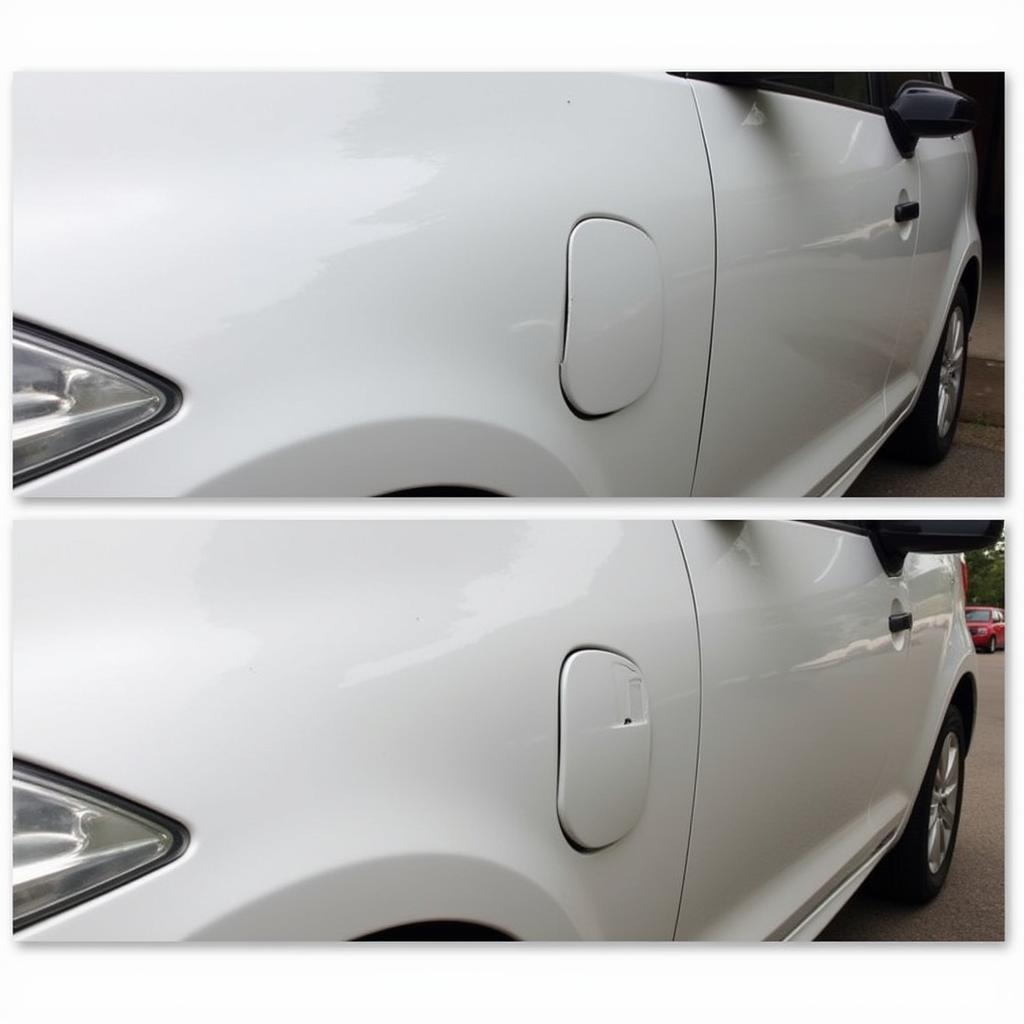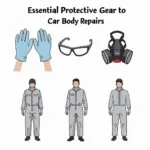Small chips in your car’s paint are annoying, but thankfully, they’re usually easy to fix yourself. Ignoring them can lead to rust and more extensive damage down the road, so addressing them promptly is key. This guide will walk you through how to repair small chips in car paint, saving you a trip to the body shop and keeping your car looking its best.
You’ll discover different methods, from touch-up paint to professional-grade kits, allowing you to choose the best approach for your situation and budget. We’ll also cover essential preparation steps and techniques for a seamless finish. Let’s get started!
Assessing the Damage: What Kind of Chip Are You Dealing With?
Before diving into the repair process, it’s crucial to assess the damage. Is it just a superficial scratch, or has the chip penetrated down to the metal? This determination will influence the repair method you choose. A small, surface-level chip can often be addressed with touch-up paint, while deeper chips exposing the metal require more attention to prevent rust. repair small paint chips on car provides a comprehensive guide on different chip types and corresponding solutions.
Superficial Chips: A Quick Fix
For minor chips that haven’t reached the primer or metal, a simple touch-up paint application may suffice.
Chips Reaching the Primer: A Little More Effort
If the chip has gone through the color coat and reached the primer, you’ll need to apply a primer coat before the touch-up paint. This ensures proper adhesion and color matching.
Chips Down to the Metal: Rust Prevention is Key
Chips that expose bare metal require immediate attention to prevent rust. This involves cleaning the area thoroughly and applying a rust inhibitor before priming and painting. how to repair small paint chips car down to metal offers detailed instructions for this specific scenario.
Gathering Your Supplies: The Right Tools for the Job
Regardless of the chip’s depth, you’ll need a few essential supplies:
- Touch-up paint: Obtain the exact color code for your car to ensure a perfect match.
- Primer (if needed): Use automotive primer for best results.
- Applicators: Fine-tipped brushes, toothpicks, or touch-up pens work well.
- Cleaning solution: Isopropyl alcohol is ideal for degreasing the area.
- Sandpaper (if needed): Fine-grit sandpaper for smoothing the area.
- Masking tape: Protects surrounding areas during the repair.
- Clear coat (optional): Provides extra protection and shine.
how to repair small car paint chips offers more specific guidance on choosing the appropriate touch-up paint and supplies for your specific repair.
Step-by-Step Guide: How to Repair Those Pesky Chips
Here’s a general guide for repairing small chips in your car’s paint:
- Clean the area: Thoroughly clean the chipped area with isopropyl alcohol to remove dirt, wax, and grease.
- Sand if necessary: If the chip is rough or has raised edges, lightly sand the area with fine-grit sandpaper.
- Apply primer (if needed): If the chip goes down to the primer or metal, apply a thin coat of automotive primer to the affected area and allow it to dry completely.
- Apply touch-up paint: Carefully apply the touch-up paint to the chip, using a fine-tipped brush or touch-up pen. Apply thin coats, allowing each coat to dry before applying the next. Avoid applying too much paint at once, as this can lead to runs and drips.
- Apply clear coat (optional): Once the touch-up paint is dry, you can apply a thin layer of clear coat for added protection and shine.
Expert Advice: Tips from the Pros
“When repairing small paint chips, patience is key,” says renowned auto detailer, Michael Davies. “Applying multiple thin coats allows for better control and prevents runs and drips.”
He also emphasizes the importance of color matching. “Ensure you use the correct touch-up paint for your car’s specific color code. A slight mismatch can be noticeable, especially in direct sunlight.”
“Don’t forget the importance of a clean working environment,” adds Sarah Johnson, a seasoned automotive painter. “Dust and debris can contaminate the paint and compromise the repair.”
Conclusion: Maintaining Your Car’s Flawless Finish
Repairing small chips in your car paint is a straightforward process that can prevent further damage and maintain your car’s appearance. By following these steps and using the right tools, you can achieve professional-looking results and keep your car looking its best. Remember to address these chips promptly to avoid rust and more costly repairs down the line. small car paint chip repair offers further guidance on preventing paint chips and maintaining your car’s finish.
FAQs
-
How long does it take for touch-up paint to dry? Typically, touch-up paint dries to the touch within 30-60 minutes, but it’s best to allow 24 hours for complete curing before washing or waxing the area.
-
Can I use nail polish to repair a car paint chip? While tempting, nail polish is not formulated for automotive use and won’t provide a durable or color-accurate repair.
-
What if the chip is larger than a dime? For larger chips or more extensive damage, it’s best to consult a professional auto body shop.
-
Can I sand the touch-up paint to blend it in? Yes, you can lightly sand the dried touch-up paint with fine-grit sandpaper to create a smoother, more blended finish.
-
Where can I find my car’s paint code? Your car’s paint code is usually located on a sticker inside the driver’s side doorjamb, glove box, or under the hood.
 Finished Car Paint Chip Repair
Finished Car Paint Chip Repair
For more specific location information or advice regarding car paint repair in East Sussex, consider visiting car paint repair east sussex. Also, you might find helpful tips for fixing small paint scratches on your car.
Need help with other car repairs? Check out our article on repairing small dents.
Need immediate assistance? Contact us via WhatsApp: +1(641)206-8880, or Email: [email protected]. Our customer service team is available 24/7.

